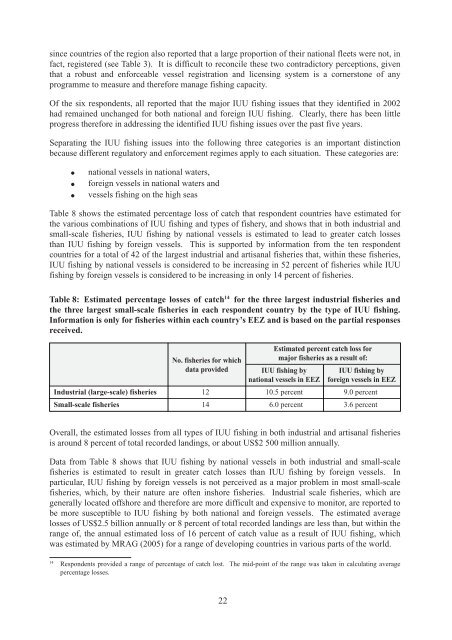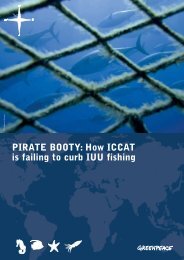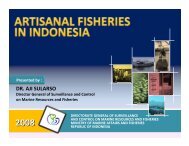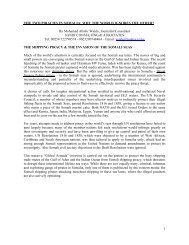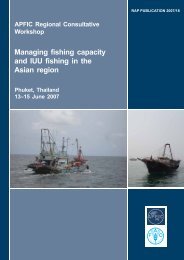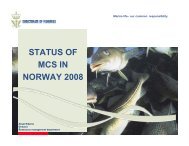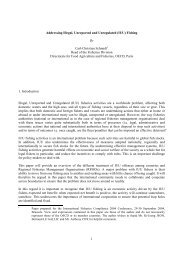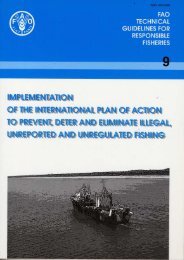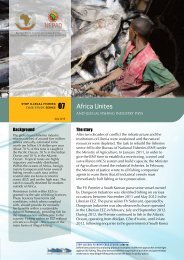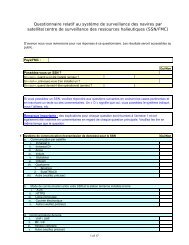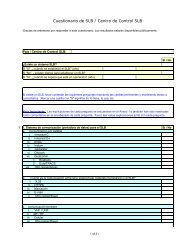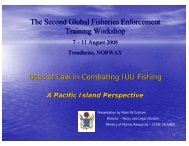Fishing capacity management and IUU fishing in Asia - FAO.org
Fishing capacity management and IUU fishing in Asia - FAO.org
Fishing capacity management and IUU fishing in Asia - FAO.org
You also want an ePaper? Increase the reach of your titles
YUMPU automatically turns print PDFs into web optimized ePapers that Google loves.
s<strong>in</strong>ce countries of the region also reported that a large proportion of their national fleets were not, <strong>in</strong>fact, registered (see Table 3). It is difficult to reconcile these two contradictory perceptions, giventhat a robust <strong>and</strong> enforceable vessel registration <strong>and</strong> licens<strong>in</strong>g system is a cornerstone of anyprogramme to measure <strong>and</strong> therefore manage <strong>fish<strong>in</strong>g</strong> <strong>capacity</strong>.Of the six respondents, all reported that the major <strong>IUU</strong> <strong>fish<strong>in</strong>g</strong> issues that they identified <strong>in</strong> 2002had rema<strong>in</strong>ed unchanged for both national <strong>and</strong> foreign <strong>IUU</strong> <strong>fish<strong>in</strong>g</strong>. Clearly, there has been littleprogress therefore <strong>in</strong> address<strong>in</strong>g the identified <strong>IUU</strong> <strong>fish<strong>in</strong>g</strong> issues over the past five years.Separat<strong>in</strong>g the <strong>IUU</strong> <strong>fish<strong>in</strong>g</strong> issues <strong>in</strong>to the follow<strong>in</strong>g three categories is an important dist<strong>in</strong>ctionbecause different regulatory <strong>and</strong> enforcement regimes apply to each situation. These categories are:●●●national vessels <strong>in</strong> national waters,foreign vessels <strong>in</strong> national waters <strong>and</strong>vessels <strong>fish<strong>in</strong>g</strong> on the high seasTable 8 shows the estimated percentage loss of catch that respondent countries have estimated forthe various comb<strong>in</strong>ations of <strong>IUU</strong> <strong>fish<strong>in</strong>g</strong> <strong>and</strong> types of fishery, <strong>and</strong> shows that <strong>in</strong> both <strong>in</strong>dustrial <strong>and</strong>small-scale fisheries, <strong>IUU</strong> <strong>fish<strong>in</strong>g</strong> by national vessels is estimated to lead to greater catch lossesthan <strong>IUU</strong> <strong>fish<strong>in</strong>g</strong> by foreign vessels. This is supported by <strong>in</strong>formation from the ten respondentcountries for a total of 42 of the largest <strong>in</strong>dustrial <strong>and</strong> artisanal fisheries that, with<strong>in</strong> these fisheries,<strong>IUU</strong> <strong>fish<strong>in</strong>g</strong> by national vessels is considered to be <strong>in</strong>creas<strong>in</strong>g <strong>in</strong> 52 percent of fisheries while <strong>IUU</strong><strong>fish<strong>in</strong>g</strong> by foreign vessels is considered to be <strong>in</strong>creas<strong>in</strong>g <strong>in</strong> only 14 percent of fisheries.Table 8: Estimated percentage losses of catch 14 for the three largest <strong>in</strong>dustrial fisheries <strong>and</strong>the three largest small-scale fisheries <strong>in</strong> each respondent country by the type of <strong>IUU</strong> <strong>fish<strong>in</strong>g</strong>.Information is only for fisheries with<strong>in</strong> each country’s EEZ <strong>and</strong> is based on the partial responsesreceived.No. fisheries for whichdata providedEstimated percent catch loss formajor fisheries as a result of:<strong>IUU</strong> <strong>fish<strong>in</strong>g</strong> by <strong>IUU</strong> <strong>fish<strong>in</strong>g</strong> bynational vessels <strong>in</strong> EEZ foreign vessels <strong>in</strong> EEZIndustrial (large-scale) fisheries 12 10.5 percent 9.0 percentSmall-scale fisheries 14 06.0 percent 3.6 percentOverall, the estimated losses from all types of <strong>IUU</strong> <strong>fish<strong>in</strong>g</strong> <strong>in</strong> both <strong>in</strong>dustrial <strong>and</strong> artisanal fisheriesis around 8 percent of total recorded l<strong>and</strong><strong>in</strong>gs, or about US$2 500 million annually.Data from Table 8 shows that <strong>IUU</strong> <strong>fish<strong>in</strong>g</strong> by national vessels <strong>in</strong> both <strong>in</strong>dustrial <strong>and</strong> small-scalefisheries is estimated to result <strong>in</strong> greater catch losses than <strong>IUU</strong> <strong>fish<strong>in</strong>g</strong> by foreign vessels. Inparticular, <strong>IUU</strong> <strong>fish<strong>in</strong>g</strong> by foreign vessels is not perceived as a major problem <strong>in</strong> most small-scalefisheries, which, by their nature are often <strong>in</strong>shore fisheries. Industrial scale fisheries, which aregenerally located offshore <strong>and</strong> therefore are more difficult <strong>and</strong> expensive to monitor, are reported tobe more susceptible to <strong>IUU</strong> <strong>fish<strong>in</strong>g</strong> by both national <strong>and</strong> foreign vessels. The estimated averagelosses of US$2.5 billion annually or 8 percent of total recorded l<strong>and</strong><strong>in</strong>gs are less than, but with<strong>in</strong> therange of, the annual estimated loss of 16 percent of catch value as a result of <strong>IUU</strong> <strong>fish<strong>in</strong>g</strong>, whichwas estimated by MRAG (2005) for a range of develop<strong>in</strong>g countries <strong>in</strong> various parts of the world.14Respondents provided a range of percentage of catch lost. The mid-po<strong>in</strong>t of the range was taken <strong>in</strong> calculat<strong>in</strong>g averagepercentage losses.22


